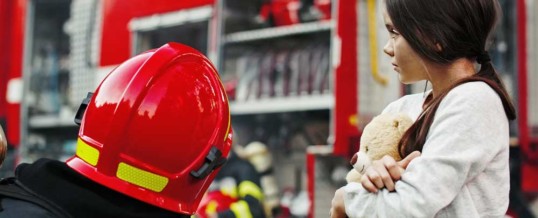
“I hope all first responders, from police officers to EMTs, and indeed the whole of society, learn about severe autism, not just TV-version autism.” – Adrienne, mother of a daughter on the autism spectrum, helped by an off-duty police officer to avoid harm to her daughter during a meltdown.
Whether a first responder has training in how to approach someone with autism can make a huge difference for many families at crucial times. People with autism tend to react differently and get overwhelmed more easily than neurotypical individuals due to various sensory sensitivities.
These factors, along with the communication challenges that are associated with the disorder, means that there is a lot of opportunity for confusion and actions that can be misinterpreted or can cause additional escalation during emergency situations.
These behaviors include things such as avoiding eye contact, being unsteady on their feet, appearing agitated or pacing, not complying with directions, and being sensitive to touch. We will share a combination of stories of interacting with someone with autism under duress and how various first responders have thought training was helpful for their departments.
Autism training for first responders helps to understand autism spectrum disorder, recognize someone that might be on the autism spectrum, how to interact with them, and how to best manage risk in high-stress situations with someone on the spectrum.
Prevalence of Autism is Rising Quickly
Autism Spectrum Disorder, or ASD, is rapidly becoming one of the most common disorders in the United States. The CDC states that 1 in every 44 children is diagnosed with autism.
ASD can be a tricky disorder to identify and treat due to the fact that it creates a completely unique experience for each impacted individual. A common saying in the autism community is “if you’ve met one person with autism, you’ve met one person with autism”. This saying illustrates the complexity of ASD and how it affects everyone very differently.
While ASD is unique for each individual, it generally causes significant challenges in the areas of social and behavioral development along with communication.
Avoid Tragedies with Autism Training
Unfortunately, the majority of first responders are not receiving enough training in order to understand autism and know how to approach these individuals during emergencies. This lack of knowledge and training can lead to dangerous mistakes or delay the time in which that person can be moved away from a dangerous situation.
Autism training for first responders is so important because it brings awareness to autism and this awareness alone can prevent horrible misunderstandings that cannot be reversed.
An individual with autism will very likely display behavior that, if untrained in this area, first responders could easily mistake as guilt, suspicious activity, or they might assume the person is under the influence of alcohol or drugs, and they also may not approach that person in an effective way if they need to conduct a physical examination or physically assist the person away from a dangerous situation.
“They may be using their hands, wringing their hands, and it may look like someone who’s in crisis in some way,” said Chief Deputy Jon Snowden of the Delaware County Sheriff’s Department.

Individuals who have autism are seven times more likely to have interactions with police and are 160 times more likely to die due to drowning. Children with autism are also prone to escaping from their parents, running away, and hiding in small spaces. When first responders and emergency services don’t know how to properly handle these cases, there is a higher risk of making the situation more dangerous than it has to be.
Emergency situations are extremely overwhelming and distressing for individuals with ASD. These environments can cause them to react by yelling, running away, resisting assistance, or hitting and kicking. An emergency medical responder cannot use typical tactics to calm this person, such as asking questions or using touch, as this will likely worsen the individual’s behavior and the first responder might assume they are being noncompliant or even threatening.
“It is essential for first responders to understand autism and be prepared to respond effectively and safely,” said Josh Westrich, Fire Chief of Whitestown Fire Station.
As we are seeing, it is not enough just to learn about autism. This is important, but first responders require training in order to fully understand how to start creating changes in their behaviors when responding to situations involving those with autism.
Basic Training Isn’t Enough
A study conducted in 2015 analyzed 75 emergency medical responders, who had different levels of training, to determine how they would handle a simulated emergency involving multiple victims, one of which had autism.
The results from the study are shocking and exemplify how crucial autism training is for first responders.
Out of the 75 medical responders, only 35 percent identified that the victim had a disability and only 13 percent thought that it was autism. 27 percent were able to provide comfort, but in some cases the comfort that was offered ended up causing more distress in the victim.
Less than half of the responders used helpful tactics, such as a soothing voice, explaining to the victim what was going on, and asking them permission before touching them.
The study discovered that the level of experience between the responders had very little impact on their performance. Those with extensive experience did not show greater skill when it came to working with the individual who had autism. The conclusion is that typical training already being provided on the job is not sufficient.
Autism is Being Addressed Nationwide
First responders all over the United States are realizing how important autism training has become.
More Departments are Seeking Professional Autism Training and Certification
More departments are leading the way and investing in evidence-based training and even certification to make sure their teams are knowledgeable in the area of autism and sensory disorders.
For example, one of the leading departments in this area is Mesa Fire and Medical in Mesa, Arizona. Mesa Fire and Medical Department joined more than 60 organizations in and near Mesa, AZ, to become a Certified Autism Center™ (CAC) in January of this year in an effort to create a truly inclusive community. The CAC designation means that staff, firefighters and first responders at Mesa Fire and Medical received position-specific training to enhance their understanding and sensitivity when helping individuals with autism or other sensory sensitivities.
“It is truly incredible to see the groundswell of support and commitment to the autism certification initiative here in Mesa,” Visit Mesa spokesperson Michelle Streeter said.
Other Tools That Can Help
Autism training can support other initiatives and tools such as as sensory kits, so that they are able to soothe individuals with autism and other special needs in emergencies. These kits include things like noise-cancelling ear muffs for loud noises, sunglasses for bright lights, a weighted blanket, and sensory toys and fidget devices.
Fire departments in Barre and Montpelier, Vermont, are the first two in their state to begin using these sensory kits.
“When we are dealing with someone on the autism spectrum, […] they can be out of control, they can hurt themselves and having tools in our tool chest allows us to really be able to defuse them and make it a better experience,” said Barre Deputy Fire Chief Joseph Aldsworth.
Rob Warnemuende, the MMR Paramedic Supervisor in Michigan, has also started implementing these sensory kits. He shares, “Having some of these tools is going to help us a lot. The lights are bright, the sirens are loud. With the headphones, with the sunglasses, (we can) keep them calm, that’s key.”
Another effort to promote autism awareness happened in McCandless, Pennsylvania, where a sticker program was launched. The program asks that families with those who are on the spectrum place a designated sticker on the window of their home or car in order to alert first responders of their presence.
This program gives first responders the awareness that someone with autism might be involved in the emergency situation, which allows them to reevaluate their strategy and approach.
Knowledge Impacts Lives
A mother’s gratitude went viral when a firefighter helped calm her daughter who has autism. In Wheatland, California, first responders from the Wheatland Fire Authority visited a preschool to teach the children about fire safety. The mother’s daughter was feeling overwhelmed by the new faces. One of the firefighters picked up on this and was able to use his knowledge of autism to help soothe her. The mother later found out that the firefighter had a family member with autism, explaining his knowledge and experience with the disorder. You can enjoy the heartfelt story here.
Awareness Isn’t Enough: Autism Training and Certification
Having an awareness of autism is not enough for first responders.
While sensory kits and sticker programs are very helpful, these efforts need to be followed up with training so that first responders are not just aware of when someone with autism is present or able to provide them with soothing materials, but so they also know what to do in these situations to be most effective.
Learn More About First Responder Certification & Training
JUL